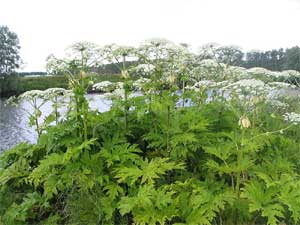Giant Hogweed
This is more of a PSA than anything else and not knowing what to look for can result in temporary or permanent blindness, serious burns on the skin, and reoccurring blisters that react to the sunlight.
What is it?
Throughout Canada, we are seeing the spread of giant hogweed and many municipalities are putting funds towards the eradication of this very dangerous plant. A plant that is part of the carrot or parsley family, the large flower head looks similar to Queen Anne’s Lace but much bigger. Growing to 5.5m tall in ideal conditions with a purple-spotted stalk 5-10cm in diameter, the seeds of the giant hogweed remain viable for 7-15 years.
A few other characteristics:
- Takes 3-5 years to produce flowers
- Flower May – July, each plant can produce up to 100,000 seeds
- Ideal soil is rich and damp but can tolerate a wide range of light conditions
Where is it found?
Giant hogweed is most often found in ditches, along roadsides, forest edges, disturbed areas and beside streams.
Who is affected?
Everyone. The sap affects human skin and eyes. The sheer size of the plant makes it attractive to children (swordfights, forts) so it is imperative that your kids know how to identify this plant and know to always keep an eye out for it if they are walking off a trail.
Pets can also pick up the sap while they are out so keep an eye out in the areas where your dog or cat roams. If you suspect he/she has come in contact with the plant, don’t touch them. The sap will not affect them but it can transfer to you. Using gloves, wash your pet with soap and water.
If you find hogweed…
Do everything you can not to touch the plant. Stalks, leaves, and bristles are poisonous. If you see giant hogweed on your property or even while out walking, call the local authority on the subject, in Ontario this is the Ministry of Natural Resources; in BC, you can call 1-888-WEEDSBC (933722).
If you touch the plant accidentally, wash the area very well with soap and water. Do not expose the area to sunlight for 1-2 weeks to avoid post-exposure blistering. Seek medical attention immediately if the sap comes into contact with eyes.
For more information and some great photos of the plant for ID purposes, visit weedinfo.ca.




